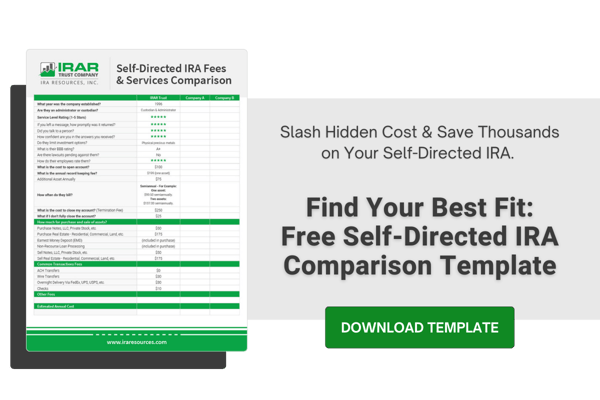Partnering Your IRA to Invest in Real Estate: Step by Step

So, you want to invest in real estate with your IRA, but don’t have enough money to buy the property outright. Does that mean you’re stuck investing in stock? No! Lucky for you, there are plenty of other options for determined investors. Today we’re going to cover one of the most common: partnering your IRA funds.
What is IRA Partnering?
Partnering is when you combine your IRA funds— either with funds from someone else, another IRA, or your personal funds— to invest with a self-directed IRA. Self-Directed IRA investors often choose to partner to maximize their investment opportunity and the funds they have available. Partnering your IRA may let you to pay for a property outright, or at the very least make a larger investment.
Who Can I Partner With?
On a new transaction, you can partner with anyone— even yourself or another disqualified person. A disqualified person is you, your spouse, and your lineal ascendants and descendants (children, grandchildren, etc). You can partner using your IRA funds from multiple IRAs, partner IRA and personal funds, or partner with your children, spouse, friend, business partner and/or their IRAs. The potential is endless! — and this is one of the few times you can invest with a disqualified person, so take advantage.
What’s Considered a New Transaction?
An investment is considered a new transaction if this is the first purchase of the investment property. So, if your IRA is newly purchasing the property, you can partner with anyone you’d like. If the IRA decides, at some point in the future, to sell part of the investment and bring in a partner, this wouldn’t be considered a new transaction. In this situation, the IRA wouldn’t be able to bring in a disqualified person as a partner.
If you’d like more information on what is considered a new transaction, you can contact an IRA Resources representative.
How Do I Partner with My Self-Directed IRA?
So, partnering sounds pretty good and you’re ready to get started— great! Here’s what you need to do to start investing with your self-directed IRA:
Step 1 – Open Your Self-Directed IRA
If you haven’t already, you’ll need to open a self-directed IRA before you start investing. To do this, you’ll need to complete and return our Account Application Kit along with a copy of your photo ID, and the $100 account opening fee. See our fees page if you’d like more detailed information on the costs of a self-directed IRA.
Relevant: Download this chapter from our Real Estate IRA eBook
Step 2 – Fund Your Self-Directed IRA
The next step is to move money into your account, so you can make your investment. There are 3 ways to do this— you can make an IRA contribution, an IRA transfer from a previous custodian, or a rollover from another retirement account. Most commonly, real estate investors transfer or rollover their funds. For either of these methods, you’ll need a recent statement from the account the funds are coming from, along with the appropriate form (either an Account Transfer Form or Rollover/Direct Rollover Certification Form). If you have other questions about this process or which method is appropriate for you, an IRA Resources representative would be happy to help you.
Step 3 – Finalize the Partner Details
Next, it’s time to find a partner to help you fund this deal! Once you’ve located a trustworthy partner you’ll need to spell out how the partnership will be structured. Make sure both you and any partner you bring in on this deal understand how the process works before making your investment. When partnering, each partner is purchasing a specific percent of the investment property, and all income and expenses need to be divided according to the same percentage. Making sure everyone has a clear understanding can help to prevent major headaches down the road.
Step 4 – Find an Investment Property
Once you’ve found a partner and worked out the details, you’ve got to find your investment property. How you do this varies from investor to investor, but there are plenty of resources on the web. As a Self-Directed IRA provider, IRA Resources does not promote specific investments.
Step 5 – Make an Offer on Your Investment
After the prep work is taken care of, it’s time to make an offer on your property! This process is otherwise similar to any other real estate IRA purchase, but you need to make sure to title all documents in the name of both the IRA and the partners, with the appropriate percentages spelled out explicitly. For example, if two IRAR clients decided to partner on a real estate investment, the documents would read:
IRAR Trust FBO John Doe IRA #12345 an undivided 50% interest
IRAR Trust FBO Jane Doe IRA #56789 an undivided 50% interest
From there, the process is much like a typical real estate closing, except all expenses during the process must be split and paid according to percentage of ownership. The fee for a real estate purchase at IRA Resources is $175, with a fee for the method you use to send the funds to your investment ($7 for a check, $30 for a wire, no charge for an ACH).
Partnering: Is This the Strategy for You?
Many IRA investors don’t realize they can partner, and with individuals you normally can’t partner with, when opening a self-directed IRA. This makes it a particularly useful strategy for self-directed investors— just think of the additional opportunities! If you’d like more details about the process, call us— we’d love to help. Why not ask your partners to join the call?
Whether you’re partnering to buy the real estate through a direct purchase, a non-recourse loan, or holding the property in an IRA LLC, reach out to an IRAR representative and we’ll answer all you & your partner’s Self-Directed IRA questions.









Comments (6)